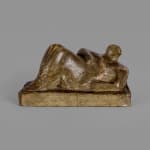Henry Moore 1898-1986
8 x 16 x 8.5 cm
The present work represents one of Henry Moore’s most recognisable and iconic motifs and was a theme he continually returned to throughout his career. Motivated in part from a practical perspective, the reclining figure offered Moore greater compositional and spatial options in contrast to a standing form due to the sculpture’s lower centre of gravity. Yet in his exploration of this universal figurative theme, we also see the evolution of Moore’s abstraction. Indeed, the environment within which he spent his early years form a familiar accompanying subject here, with the human figure also suggestive of an undulating landscape. This piece is an early example of one of Moore’s reclining figures, which he only began to experiment with from 1926, and is evidenced by the chosen material. His works in concrete have an almost archaic quality and were influenced by pre-Columbian art, but in this sculpture we find contours reminiscent of hills and rock formations running parallel with Moore’s abstraction of the human figure.
Provenance
Erica Brausen, acquired directly from the artistGifted to Jean-Yves Mock, who was curator at the Pompidou (1928-2021)
Private collection, UK
Literature
D. Sylvester (ed.), 'Henry Moore: Complete Sculpture 1921-48, Vol.1', London, 1990, p.8 no.120a;The Henry Moore Foundation Artwork Catalogue, cat.no.LH 120a stone;
J. Hedgecoe, 'A Monumental Vision: The Sculpture of Henry Moore', London, 1998, p.200, no.108, bronze cast illus.




